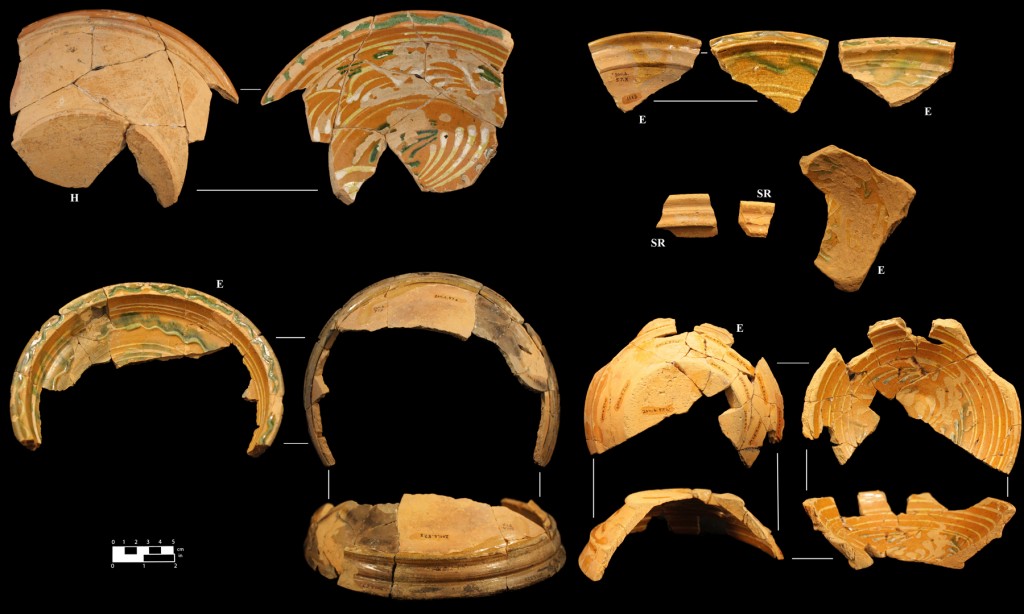March 2013 — Artifact of the Month
Back to Main Page…
Artifact of the Month Index
REDWARE FROM THE HILLEGAS POTTERY
 Red earthenware vessels recovered from Excavation Unit 43, Context 5, Elkins B Site. Vessels marked with an (E) were recovered from the Elkins B Site and are thought to be manufactured by the Hillegas Brothers in Philadelphia circa 1720-1746. These vessels are compared with examples from the Hillegas Pottery site (H) and from the Scott Run historic site (SR). Top row (left to right): two sizes of shallow bowls with folded, rounded rims from the Hillegas Pottery site; a porringer with a tapered body from the Hillegas Pottery site; and a similar porringer handle/body sherd from the Elkins B site. Bottom row (left to right): rim sherds from the Elkins B Site and the Scott Run historic site with folded and rounded rims similar to those pictured above from the Hillegas Pottery site; a large redware bowl or milk pan rim sherd with an incised wavy line from the Elkins B Site; a redware storage jar with a similar incised wavy line from the Hillegas Pottery site (Photographers: Justin Colon and Lindsay Lee, October 2011) [HRI Neg.#11017/D9:008].
Red earthenware vessels recovered from Excavation Unit 43, Context 5, Elkins B Site. Vessels marked with an (E) were recovered from the Elkins B Site and are thought to be manufactured by the Hillegas Brothers in Philadelphia circa 1720-1746. These vessels are compared with examples from the Hillegas Pottery site (H) and from the Scott Run historic site (SR). Top row (left to right): two sizes of shallow bowls with folded, rounded rims from the Hillegas Pottery site; a porringer with a tapered body from the Hillegas Pottery site; and a similar porringer handle/body sherd from the Elkins B site. Bottom row (left to right): rim sherds from the Elkins B Site and the Scott Run historic site with folded and rounded rims similar to those pictured above from the Hillegas Pottery site; a large redware bowl or milk pan rim sherd with an incised wavy line from the Elkins B Site; a redware storage jar with a similar incised wavy line from the Hillegas Pottery site (Photographers: Justin Colon and Lindsay Lee, October 2011) [HRI Neg.#11017/D9:008].
A minimum of nine redware vessels have been recovered from the Elkins B archaeological site near Middletown, Delaware. These vessels have been preliminarily identified as products of Philadelphia redware potters George-Peter Hillegas and Michael Hillegas. The Hillegas brothers, who were German immigrants of French Huguenot descent, came to Philadelphia in the early 1720s and began making pottery around 1728. They owned a property on Second Street in the years between 1735 and 1746. In 1991, Hunter Research, Inc. conducted archaeological investigations at this location and encountered large pits filled with redware waster materials. The colletion was analyzed in 2002 as part of an Master’s Degree thesis study by archaeologist George Cress.
Rim sherds From the Elkins Locus B site exhibit folded lips that are rounded or tooled — a treatment that is similar to 17th-century North Holland and Low Country slipwares (Jennings et al. 1981:85-93). Rim diameters from three of the recovered bowls or shallow dishes range from 6.5 to 9 inches. Cress has suggested these represent graduated nesting sets that were intended for sale. Sherds from the Elkins B Site exhibit interior decoration consisting of central pinwheels (with counterclockwise sprays) bordered by verdigris green and white slip wave and band combinations identical to decoration observed on vessels produced by the Hillegas brothers (Cress 2002). Three identical rim sherds were recovered from the nearby Scott Run Historic Site [7NC-G-179] suggesting some kind of a connection between the two sites. Other recovered vessel forms thought to be made by the Hillegas brothers are storage vessels/crocks, a milk pan with a distinctive incised wavy line similar to incised lines found on some Hillegas storage vessels, a dark brown, manganese glazed porringer with a slightly flared, tapered, rounded rim, and a wheel thrown plate/charger.
Submitted by Bill Liebeknecht, MA, RPA, Hunter Research, Inc.
(Previous) Artifacts of the Month Index
Back to Main Page…
by admin